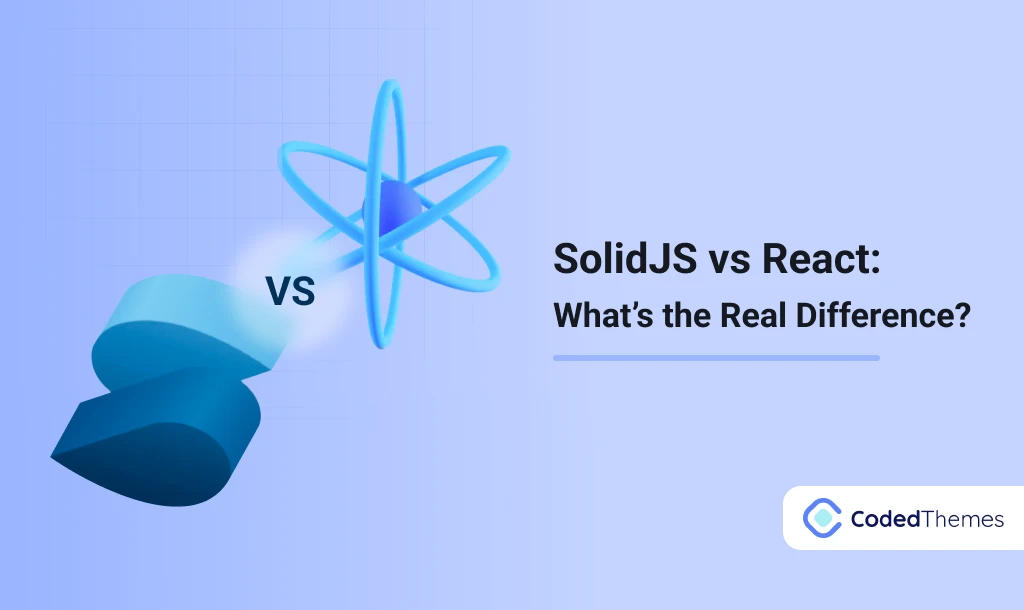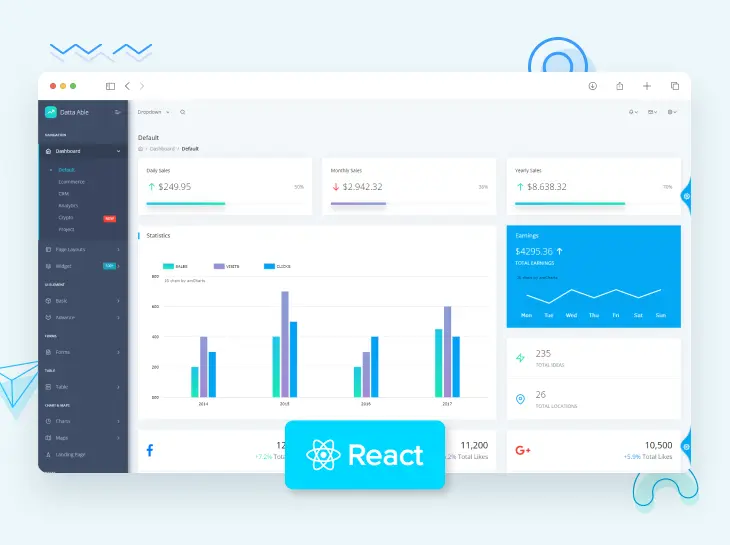In 2025, frontend developers seem to circle back to the same debate: SolidJS vs React. React is still everywhere from enterprise dashboards to personal projects but SolidJS is quietly earning a reputation for being faster and lighter.
The rise of AI-assisted coding tools has amplified the conversation. A few years ago, SolidJS felt intimidating because resources were limited. Now, you can ask an AI assistant to explain an error or write a component, and suddenly the gap in documentation doesn’t feel as wide.
That doesn’t mean React is “dying.” Far from it. The real question is whether SolidJS has reached the point where it makes sense for more developers to pick it up, not just the early adopters.
What is React?
React, created by Facebook in 2013, is a JavaScript library for building UIs. If you’ve written frontend code at all in the last decade, there’s a good chance you’ve used it or at least touched a React-like ecosystem.
ts popularity came from a simple but powerful idea: break UIs into components. A login form, a navigation bar, or a comment section all become reusable pieces that can be plugged into different parts of an app. This approach makes large applications easier to structure.
Underneath, React uses the Virtual DOM. When your app’s state changes, React doesn’t redraw everything, it compares the “before” and “after” versions and updates only what’s necessary. That trade-off worked wonders in 2013 when browsers were slower, and it still performs well today.
React’s ecosystem is huge: Next.js for SSR, React Native for mobile apps, thousands of ready-made libraries. That scale explains why many beginners start here, it’s easier to find answers, templates, and tutorials than almost anywhere else.
What is SolidJS and why is it getting popular in 2025?
SolidJS is also a JavaScript library for building UIs, but it works differently. Instead of a Virtual DOM, it uses fine-grained reactivity. In plain terms, only the parts of the UI that actually change get updated. No diffing process, no big comparison step.
Why are people paying attention now?
- Performance: SolidJS is extremely fast, even compared to other modern frameworks.
- Smaller bundle sizes: This matters if you’re trying to make your app load quickly on mobile or slower networks.
- Developer interest: After a decade of React, many devs are curious to try something that feels familiar but less heavy.
It’s not just hype. SolidJS has production use cases in dashboards, admin tools, and lightweight SPAs. And with AI tools smoothing out the learning process, more developers are experimenting with it.
How does SolidJS work vs React?
The fundamental difference is how updates happen:
- React: Uses a Virtual DOM. It checks what changed, then updates the necessary parts.
- SolidJS: Uses fine-grained reactivity. It updates only the exact piece tied to the data that changed.
In practice, this means SolidJS skips a step React always has to do.
When I tested a small chat app in both, the distinction was clear. React re-rendered portions of the message list every time a new one arrived. SolidJS updated only the new message. With a handful of messages, you don’t notice much. But once you’re handling hundreds, the difference in responsiveness becomes obvious.
Is SolidJS faster than React in 2025?
Most benchmarks suggest yes. SolidJS tends to outperform React in raw runtime speed and usually produces smaller bundles.
This is especially useful in apps where performance isn’t optional. Think real-time trading dashboards, IoT monitoring panels, or AI-based apps that stream large amounts of data. Even a small performance gain here can translate into a better user experience.
That said, performance isn’t everything. React paired with frameworks like Next.js can still deliver excellent results, especially for server-side rendering or SEO-heavy apps. So while SolidJS is often quicker, React has its own strengths that go beyond raw speed.
Which one is easier to learn: SolidJS or React?
It depends on your starting point.
- React is easier for beginners. The tutorials, courses, and community support are unmatched. If you hit a bug, chances are someone has already solved it on StackOverflow or GitHub.
- SolidJS has fewer resources, but AI tools change the game. In 2025, you can paste an error into ChatGPT or Copilot and get a working fix. That narrows the learning curve considerably.
So while React remains the obvious entry point, SolidJS is no longer a steep climb. A motivated beginner could probably learn it with the same ease today as React five years ago.
What are the key differences between SolidJS and React?
|
Feature |
React | SolidJS |
| Rendering Model | Virtual DOM | Fine-grained reactivity |
| Bundle Size | Larger | Smaller |
| Ecosystem | Massive, battle-tested | Growing, leaner |
| Learning Curve | Easier (tons of resources available) | Steeper, but AI helps close the gap |
| Performance | Good | Excellent |
| Backing | Meta + global community | Community-driven, open source |
Rendering model
- React: Uses a virtual DOM. State changes trigger a re-render of the component tree (with diffing and reconciliation). You often reach for memoization (memo, useMemo, useCallback) to avoid extra work in large trees.
- SolidJS: Uses fine-grained reactivity. Signals track exactly which computations depend on which values, so only the precise parts update without a virtual DOM diff. Fewer “why did this re-render?” moments, but you do need to think in signals and effects.
Performance in practice
- React: Fast enough for most apps. Lists, forms, and dashboards perform well if you structure components smartly and memorize hotspots. Concurrent features help keep the UI responsive.
- SolidJS: Generally snappier by default, especially in interaction-heavy UIs (typing, sliders, animations) and very large trees. You get fewer renders and smaller updates without extra tuning.
Bundle size
- React: Larger baseline because you ship react + renderer (e.g., react-dom) and often a state or routing library.
- SolidJS: Smaller core + compiler output, so initial bundles tend to be lighter. Good fit when you’re chasing tight performance budgets.
Learning curve
- React: Gentle start thanks to the huge pool of tutorials and examples. The tricky part comes later: managing re-renders, dependency arrays in useEffect, and memoization strategies.
- SolidJS: Feels familiar (JSX, components) but the mental model is signals over re-renders. Once it “clicks,” performance work often gets simpler because the framework does less rendering by default.
State management
- React: Hooks + Context cover many needs. Ecosystem options are mature (Redux, Zustand, Jotai, TanStack Query).
- SolidJS: Signals and stores are first-class and remove a lot of boilerplate. TanStack Query and other libs have Solid adapters as well.
Ecosystem and libraries
- React: Massive ecosystem, UI kits, charts, editors, and integrations for almost anything. It’s easy to hire for and easy to replace parts.
- SolidJS: Growing fast. Quality routers, forms, and query libraries exist, but niche components may need wrappers or custom work.
Frameworks and SSR
- React: Production-routing, and data patterns well documented.
- SolidJS: SolidStart (and Astro integrations) bring SSR/SSG and routing. It’s production-capable, but you’ll find fewer “playbook” articles and templates than React.
Developer experience & tooling
- React: Mature DevTools, lint rules, performance profilers, and stable CI/CD recipes. Most cloud platforms assume React flows.
- SolidJS: DevTools are solid (pun intended) and Vite-first DX is great. Tooling is lighter and fast, though you’ll find fewer company-standard templates.
Frameworks and SSR
- React: Production-routing, and data patterns well documented.
- SolidJS: SolidStart (and Astro integrations) bring SSR/SSG and routing. It’s production-capable, but you’ll find fewer “playbook” articles and templates than React.
Developer experience & tooling
- React: Mature DevTools, lint rules, performance profilers, and stable CI/CD recipes. Most cloud platforms assume React flows.
- SolidJS: DevTools are solid (pun intended) and Vite-first DX is great. Tooling is lighter and fast, though you’ll find fewer company-standard templates.
TypeScript
- React: Excellent TypeScript support with types across the ecosystem.
- SolidJS: Strong TypeScript story as well. Signals are well-typed and reduce “props drilling” types in some spots.
Community & backing
- React: Backed by Meta with long-term stability and a very large community.
- SolidJS: Community-driven open source with an active core team and helpful Discord/GitHub presence.
React appears safer when you want long-term support. SolidJS feels like a performance-first option that suits leaner projects.
When should you use SolidJS instead of React?
SolidJS works well when:
- You’re building SaaS dashboards that refresh data every second.
- You want lightweight SPAs that load quickly.
- You’re building real-time or AI-driven apps where performance matters.
Small-to-medium teams may also find SolidJS enjoyable, it’s less boilerplate and more direct.
When should you use React instead of SolidJS?
React still makes more sense when:
- You’re working on an enterprise app with many developers.
- You need strong ecosystem support (authentication, charts, accessibility libraries).
- You want a proven framework for long-term maintenance.
In short, if your app needs integrations with dozens of tools, React is usually the safer choice.
Will SolidJS replace React in the future?
Probably not. React has too much momentum, millions of developers, corporate investment, and a decade of tooling.
But SolidJS doesn’t need to replace React to matter. Its niche is clear: performance-heavy, smaller apps where speed is the top priority. Over time, we may see a hybrid world- React for large enterprises, SolidJS for fast-moving projects and side apps.
What do AI tools mean for SolidJS vs React developers?
AI tools change the learning curve for frameworks.
React still benefits from having more training data, so AI helpers often suggest React code more confidently. But SolidJS gains from AI too. What once required searching through GitHub issues can now be solved with a single AI query.
That makes frameworks like SolidJS more approachable. Put differently: AI gives SolidJS the “documentation boost” it lacked.
Conclusion
So where does the SolidJS vs React debate stand in 2025?
React remains the default for large teams and enterprise projects. Its ecosystem, support, and stability are unmatched.
SolidJS, however, is proving itself as a faster, lighter option. For real-time apps, dashboards, or smaller projects where speed matters, it may even be the better choice.
It’s unlikely one will replace the other. Instead, developers may start using both- React where scale matters, SolidJS where efficiency is critical.
FAQs
Is SolidJS better than React in 2025?
Not in every case. It’s faster, but React has more support and libraries.
Is SolidJS production-ready for large apps?
Yes, though you may find fewer pre-built solutions than React.
Should I learn SolidJS if I already know React?
Yes. The syntax is similar, and you’ll understand reactivity better.
How does React compare to newer frameworks like Svelte or SolidJS?
React is stable but heavier. Svelte and SolidJS are faster and lighter but have smaller ecosystems.
What are the benefits of SolidJS?
Smaller bundles, faster runtime, and a straightforward reactivity model.
Is Svelte faster than Next.js?
In raw rendering speed, yes. But Next.js provides more features for deployment and SEO.
Is Solid faster than Svelte?
Often, yes, though the difference may not matter for everyday apps.








Comments